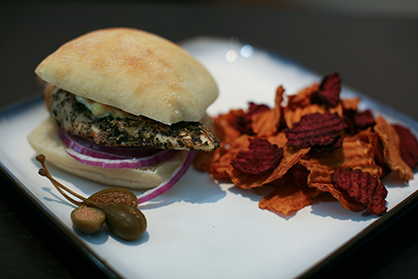
Chef's notes:
When it comes to making chicken sandwiches, the chicken breast can’t be beat. The breast has an affinity for drying out quickly because it has little moisture and/or fat itself. So, to accommodate this, we can add moisture in the form of a marinade or a rub, or we can just try really hard not to overcook it. One way to ensure we don’t overcook the chicken breast is to cook it with a digital thermometer inside. That way once the internal temp of 160ºF is reached, we can quickly remove the chicken from the heat.
I have a lot of luck flavoring my chicken breasts with herbs, salt, and pepper. The herbs I chose for this particular recipes are one of my favorite combinations. Herbes de Provence are usually some combination of thyme, savory, lavender, tarragon, marjoram, oregano, fennel, and others. There are many recipes for making your own, or simply purchase a pre-made mix at the grocery store.
Ingredients
- 3 chicken breasts
- Herbes de Provence
- Salt
- Black pepper
- Canola oil
Boneless Skinless Chicken Breasts Seasoned with Provencal Herbs, Salt and Pepper
- Buy the right chicken breasts. I have become a picky eater. I mean, I was always a little picky but now I am extremely picky. How am I picky, you may ask? It’s quite simple, really. I refuse to eat subpar food; only the best will do. So I buy the organic, free-range, no-antibiotics chicken. It costs more, but I feel the extra expense is warranted. Responsible and ethical food consumption is one of my top priorities. What are yours?
- Season the chicken breasts with herbs, salt, and pepper. The Herbes de Provence are a great blend of herbs. The most notable flavors are the thyme, lavender, and fennel. These three flavors come through clearly. The others are there, but they don’t jump out and smack you in the tongue. The best salt to use is some form of sea salt. And fresh cracked black pepper or another type of peppercorn is essential. Almost everyone should have a pepper mill in this day and age.
- Place the broiling pan under the broiler. The broiler may take a few minutes to get hot. If your broiler is gas, it may get hot instantly if it’s a good one. But all too often broiler units are kinda crappy, so you will have to keep a close eye on the meat if you haven’t broiled too many times before. Place the rack one rung down from the top. Make sure to arrange the meat on the pan so it will be under the heat source. Watch the chicken broil. Leaving the door open won’t hurt the broiling process.
- Flip the breasts and broil the other side. Once the first side is browned enough (5‒6 minutes, depending on the size), remove the pan. Flip the breasts over using a pair of spring-loaded tongs. Place the broiling pan back under the broiling unit until the internal temp of the chicken breast reaches 160ºF. Then remove the pan and turn off the broiler. Remove the breasts from the broiling pan and let them rest a couple minutes before eating.
Tips & Tricks
- Keep a close eye on the meat if you haven’t broiled often.
- Gas broilers are often hotter than electric broilers.
- Chicken breasts don’t want to be cooked slowly. The faster you cook them, the better.
- Leave the door open a crack as you broil. This will allow hot air to escape and keep the oven thermostat from automatically turning off your broiler mid-cooking.
- The cheapest way to buy chicken breasts is to buy the big bag of IQF (individually quickly frozen) chicken breasts.
- The best tasting chicken is the freshest, cleanest, and happiest chicken that you can find. If you can get home-raised chicken, that may be your best bet.
- If it smells sickly sweet or sour, throw it away.
- Broiled chicken breasts make great sandwiches. As you can see in the photo a ciabatta roll with red onion, mustard and mayo, makes a great looking lunch. Those are sweet potato chips on the side. Oh yeah!
